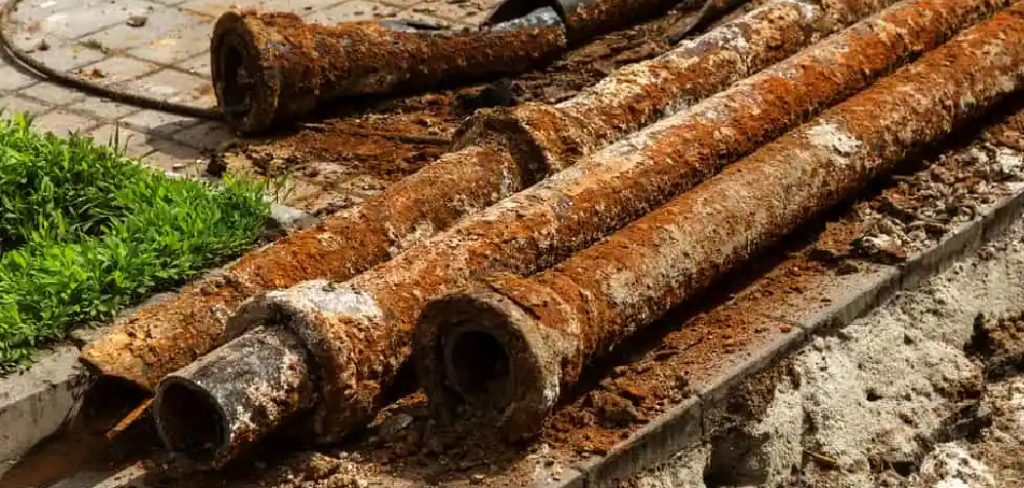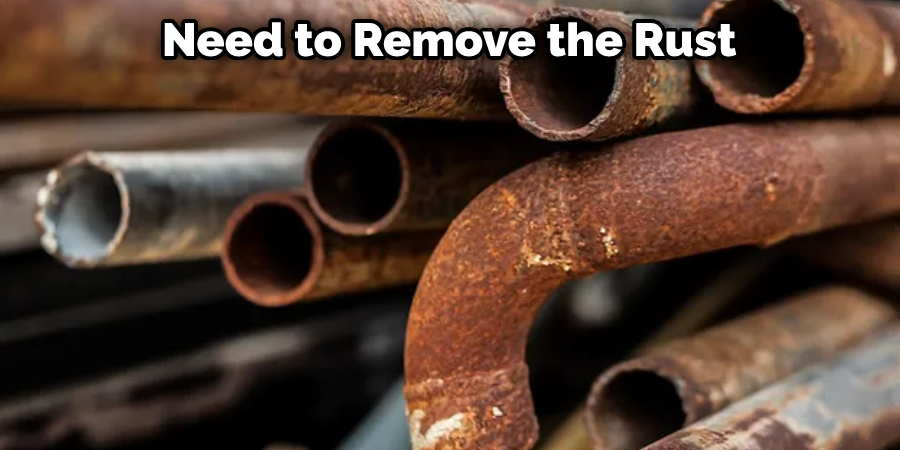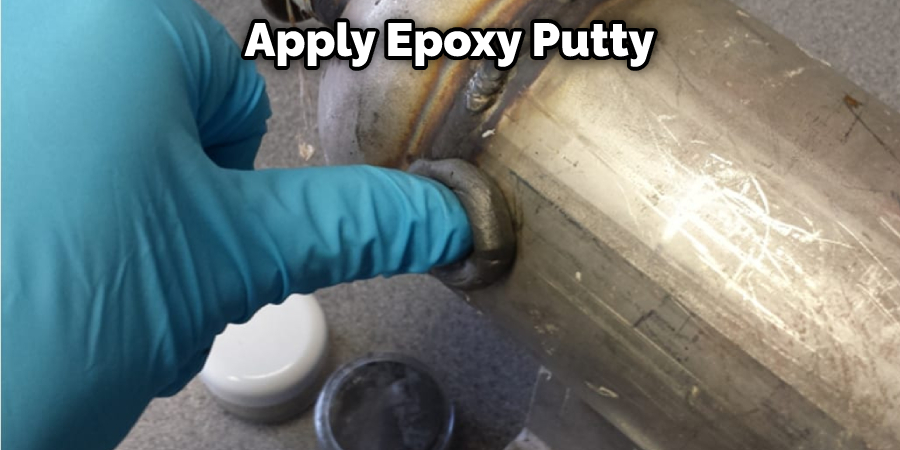Cast iron pipes have been used for centuries to transport water and other liquids. They are strong and durable, but they can also be prone to cracking. If you have a cracked cast iron pipe, there are several steps you can take to repair it. This blog post will discuss the best ways to repair cracked cast iron pipes. We will also provide steps on how to repair cracked cast iron pipe. Let’s get started!

Cast iron pipe is a type of pipe that is commonly used in residential and commercial plumbing applications. It is very durable and can last for many years, making it a great choice for plumbing.
Cast iron pipes can develop cracks over time. If left unrepaired, these cracks can cause leaks and eventually lead to the failure of the pipe. To repair a cracked cast iron pipe, you will need to first remove all the rust from the surface of the pipe.
Once the rust has been removed, you can then apply a patch to the outside of the pipe. To do this, you will need to use a putty knife to smooth the patch over the surface of the pipe. Once the patch has been applied, you can then use a clamp to secure it in place. Finally, you can paint over the patch to match the existing finish on the pipe. With these steps, you will be able to repair a cracked cast iron pipe effectively.
Summary: Cast iron pipe is often used in older homes because it is strong and durable. However, cast iron pipe can be damaged by freeze thaw cycling, which causes the pipe to crack. If the crack is large enough, water can seep through the crack and cause serious damage to your home. To repair a cracked cast iron pipe, you’ll need to remove the damaged part of the pipe and replace it with a new one.
What Causes a Cast Iron Pipe to Crack?
Cast iron pipes are made of metal and are used to transport water. They can crack due to changes in temperature or water pressure.
Ground movement can cause cast iron pipes to crack, as well as corrosion weakening the structure of the pipe. Cracks in cast iron pipes can lead to leaks, which can cause extensive damage to a home or business. If you suspect your cast iron pipe is cracked, it is important to have a professional plumber inspect the pipe and make repairs as necessary.
10 Ways on How to Repair Cracked Cast Iron Pipe
1. Use a Rust Remover
First things first, you need to remove the rust from the pipe. This can be done with several products, but we recommend using a rust remover gel. It’s easy to use and will remove the rust quickly.

2. Use a Wire Brush
Once the rust is gone, use a wire brush to remove any debris or buildup from the inside of the pipe. This will help ensure that the repair process goes smoothly. Wire brush the entire length of the pipe, including the area around the crack.
Next, apply a generous amount of sealant around the crack in the pipe. Make sure you cover the entire area around the crack so that no water can get in. Allow the sealant to dry completely before proceeding to the next step.
3. Apply Epoxy Putty
After that, apply epoxy putty to the cracked area of the pipe. Epoxy putty is a type of easily-molded material that can be used to fill in cracks and holes. You can find it at most hardware stores.
4. Wait for the Putty to Dry
Now, let the epoxy putty dry according to the manufacturer’s instructions. This will usually take around 24 hours. Use a hair dryer to speed up the process if necessary. Once the putty is dry, you can proceed to the next step.
5. Remove the Clamps
After the putty has dried, you can remove the clamps to hold the pipe together. Use a screwdriver to loosen the clamp and then carefully remove it from the pipe.

6. Sand Down the Pipe
Use fine-grit sandpaper to sand down the outside of the cracked pipe. Be sure to sand evenly to avoid further damage. In addition, sanding the pipe will help to create a smooth surface for the patch to adhere to.
8. Prime and Paint the Pipe
Use a primer designed for use on metal, and then paint the pipe with high-quality outdoor paint. If the pipe is galvanized, use a primer made specifically for galvanized metal. These products will help to protect the pipe from rust and corrosion.
7. Clean the Pipe
Once you have sanded down the pipe, use a clean cloth to wipe away any dust or debris.
8. Apply Epoxy
Apply epoxy putty to the cracked area of the pipe. Use a putty knife to spread the epoxy evenly over the crack. It is important to make sure that the epoxy is pushed into the crack so that it can create a seal.

9. Wait for the Epoxy to Dry
Let the epoxy putty dry according to the manufacturer’s instructions. This will usually take around 24 hours. Use a hair dryer to speed up the process if necessary. Once the epoxy is dry, you can proceed to the final step.
10. Test the Repair
Once the epoxy has dried, it’s time to test your repair. First, turn on the water supply and check for any leaks. If there are no leaks, then your repair is successful! If there are leaks, you may need to apply additional epoxy or try another repair method.
Cracked cast iron pipes are a common problem in many homes. But don’t worry, there are ways to repair them! You can fix your cracked cast iron pipe and get it back to working condition with a little time and effort.
Step by Step Process on How to Repair Cracked Cast Iron Pipe
Step 1: Assess the Damage and Determine Repair Method
Inspect the cracked cast iron pipe to assess the extent of the damage. Depending on the severity and location of the crack, you may be able to repair it using a pipe repair clamp, an epoxy putty, or a pipe repair sleeve. In some cases, the damaged section may need to be replaced entirely.
Step 2: Gather Necessary Tools and Materials
To repair a cracked cast iron pipe, you will need various tools and materials, such as:
- Pipe repair clamp, epoxy putty, or pipe repair sleeve (depending on the chosen repair method)
- Pipe cutter or reciprocating saw with a metal cutting blade (if replacing a section of the pipe)
- Pipe wrenches
- Adjustable wrench
- Screwdriver or drill
- Pipe joint compound or thread sealant
- Replacement pipe and fittings (if necessary)
- Pipe supports or hangers (if needed)
- Gloves and safety glasses
Step 3: Turn Off Water Supply and Drain the Pipe
Before starting any repair work, ensure that the water supply to the cracked cast iron pipe is turned off. Open faucets or drain valves to release any remaining water and pressure from the pipe.
Step 4: Clean the Cracked Area
Using a wire brush or sandpaper, clean the area around the crack to remove any dirt, rust, or debris. This will ensure proper adhesion of the repair materials and provide a better seal.
Step 5: Repair with a Pipe Repair Clamp
If you are using a pipe repair clamp to fix the crack, follow these steps:
a. Position the clamp over the crack, ensuring that the rubber gasket is centered over the damaged area.
b. Tighten the clamp’s bolts evenly, using an adjustable wrench, until the clamp is snug and the crack is sealed.
c. Test the repair by turning on the water supply and checking for leaks.
Step 6: Repair with Epoxy Putty
If you are using epoxy putty to fix the crack, follow these steps:
a. Mix the epoxy putty according to the manufacturer’s instructions.
b. Apply the putty to the crack, pressing it firmly into the damaged area and ensuring that it covers the entire crack.
c. Allow the putty to cure for the recommended time before turning on the water supply and checking for leaks.
Step 7: Repair with a Pipe Repair Sleeve
If you are using a pipe repair sleeve to fix the crack, follow these steps:
a. Cut the pipe repair sleeve to the appropriate length, ensuring that it covers the entire crack and extends at least two inches beyond the damaged area on either side.
b. Position the sleeve over the crack and tighten the sleeve’s bolts evenly, using an adjustable wrench, until the sleeve is snug and the crack is sealed.
c. Test the repair by turning on the water supply and checking for leaks.
Step 8: Replace the Damaged Pipe Section (if necessary)
If the crack is too severe to be repaired using the methods above, you may need to replace the damaged section of the pipe. Follow these steps:
a. Use a pipe cutter or reciprocating saw to cut out the damaged section of the pipe.
b. Measure and cut a new piece of cast iron pipe to fit the gap, ensuring that it matches the diameter of the existing pipe.
c. Apply pipe joint compound or thread sealant to the threads of the pipe fittings.
d. Use pipe wrenches to connect the new pipe section to the existing pipe, tightening the fittings securely.
e. Test the repair by turning on the water supply and checking for leaks.
Step 9: Reinforce and Support the Repaired Pipe
Ensure that the repaired pipe is adequately supported using pipe supports or hangers to prevent additional
stress and potential future cracks. Inspect the surrounding pipe supports and replace or adjust them as needed to provide proper support for the entire pipe system.
Step 10: Inspect and Maintain Your Cast Iron Pipes Regularly
Regular inspection and maintenance of your cast iron pipes can help prevent future cracks and other issues. Check for signs of corrosion, leaks, or other damage, and address any issues promptly to ensure the longevity of your cast iron pipes.
Step 11: Consider Pipe Replacement
If you have recurrent issues with cracked cast iron pipes, it may be time to consider replacing them with more durable and long-lasting materials, such as PVC or ABS pipes. Consult with a professional plumber to discuss your options and determine the most appropriate solution for your specific situation.
Step 12: Consult a Professional Plumber
If you are unsure about any aspect of the repair process or continue to experience issues with your cast iron pipes, consult a professional plumber for guidance and assistance. A plumber can assess the situation, identify the underlying issue, and recommend the most effective course of action to repair the cracked cast iron pipe.
By following these steps and being proactive about pipe maintenance, you can successfully repair a cracked cast iron pipe and keep it in optimal condition for years to come. Addressing issues promptly, using high-quality repair materials, and consulting a professional plumber when necessary will help ensure the durability and functionality of your cast iron pipe system.
Frequently Asked Questions
Will Flex Seal Work on Cast Iron Pipe?
While Flex Seal is safe to use on most types of surfaces, it may not be the best option for cast iron pipe. This product is designed to seal and protect concrete surfaces from moisture, but due to its high solubility in water, it can cause damage when applied to cast iron pipes. In some cases, this damage can lead to a leak or even failure of the pipe.
Therefore, if you’re considering using Flex Seal on your cast iron pipe, it’s important to test the product first by applying a small amount onto one section of the pipe. If there are no negative repercussions after 24 hours have passed (and you’re confident that the area will remain dry), then you can proceed with the application.
Can Cast Iron Be Patched?
Generally speaking, if the pan is completely unusable, patching it may not be a good option as the patch may not hold up over time. If the pan has small areas that are not damaged, a patch may be a viable option. However, if the pan has larger areas that have been damaged, a new pan may be necessary.
Can I Use Jb Weld on Cast Iron Pipe?
Cast iron pipe is a very sturdy material that is often used in construction and industrial applications. However, it’s not immune to the negative effects of corrosion and rust. Jb Weld is a safe and effective sealant that can be used to repair cast iron pipes. It’s important to note that Jb Weld should not be used to seal pipes that are in any danger of failing.
Conclusion
Cast iron pipe is a durable and long-lasting material, but it can still crack. If you do find a crack in your cast iron pipe, there are some ways to repair it before it becomes a bigger problem. We’ve outlined the steps you need to take how to repair cracked cast iron pipe, so follow these instructions closely and have your pipes fixed in no time. Have you ever had to fix a cracked cast iron pipe? What was your experience? Please write a comment below and let us know.
